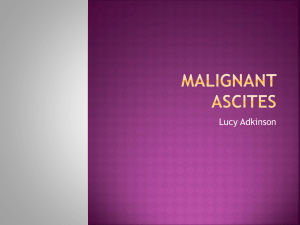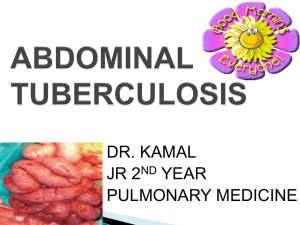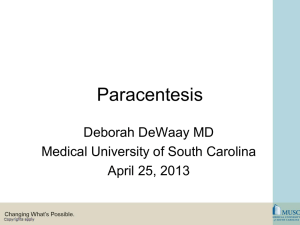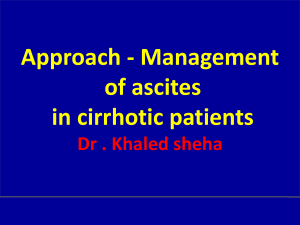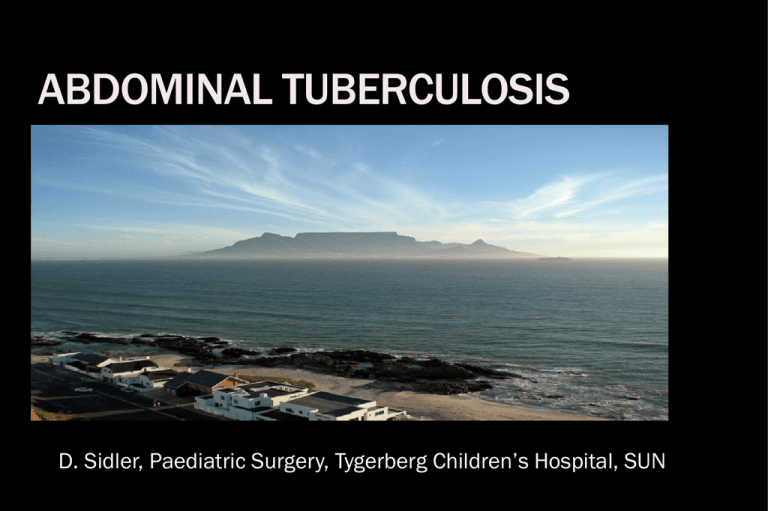
ABDOMINAL TUBERCULOSIS
D. Sidler, Paediatric Surgery, Tygerberg Children’s Hospital, SUN
GLOBAL EMERGECY
30%-50% of world population has TB (3 billion)
8-10 Mill /yr
>3 Mill in Sub-Saharan Africa
5,000 people die/d = 2.3 million/ yr
TB kills more young women than any other disease
More than 100,000 children will die from TB this year
Hundreds of thousands of children become TB orphans
CAUSES OF RESURGENCE IN INCIDENCE OF TB
Worsening economic situations
Multidrug resistance
HIV pandemic
Decline of national tuberculosis control programmes
Large number of displaced persons living in poor
conditions as a result of conflicts and wars
GREAT MIMICKER
Very varied presentation Great mimicker
TB of GIT- 6th most frequent extra-pulmonary site
TB can involve any part of GIT
HIV & TB
Before HIV era > 80% pTB
In HIV+ pt 40%–60% extra-pulmonary TB
Globally co-infected pts >8 %
Estimated HIV-TB Co-infection Prevalence, 2000
Rate per 100 000
<5
5 - 9.9
10 - 99
100 - 999
1000 - 4999
5000 or more
No estimate
Source: WHO 2002
AETIO-PATHOGENESIS
Primary (non pasteurised milk)
Secondary (sputum)
Route of abdominal infection
Direct ingestion
Haematogenous spread
Direct extension from contiguous organ
Through lymph channels
ABDOMINAL TB CLASSIFICATION
Intestinal
- ulcerative
- hyperplastic
- perforative
Peritoneal
- wet
- dry/plastic
- fibrotic fixed
- acute primary peritonitis
Mesenteric involvement
- mass
- abscess
- nodal
Solid organ
- liver , spleen, pancreas
CLINICAL PRESENTATION
Intestinal obstruction
Lump/Mass
Acute
Abscess
Subacute
LN Mass
Chronic
Bowel mass
IC mass
Omental mass
Perforation
Ascites
Diffuse
Loculated
Organized
Differential Diagnosis
Malignancy
•
•
•
Hodgkin’s lymphoma
Acute lymphocytic leukemia
Infection
•
•
•
•
•
Pyogenic lymphadenitis
Fungal infection of lymph nodes
Infection with atypical mycobacteria
HIV/AIDS
Most common site - ileocaecal region
Ileum >caecum> ascending colon > jejunum>appendix > sigmoid
> rectum > duodenum> stomach >oesophagus
Increased physiological stasis
Increased rate of fluid and electrolyte absorption
Minimal digestive activity
Abundance of lymphoid tissue
UNCOMMON PRESENTATION
Gastro-duodenal TB
Oesophagus
Segmental colonic
Rectal
Anal TB
Genitourinary TB
INVESTIGATION
Imaging
AxR
US
CT
Lab-tests
Sputum bacteriology (gram stain, culture)
Tuberculin test
Ascites ADA
FNAB/C
X-RAY ABDOMEN WITH CALCIFIED LYMPH NODE
AxR WITH INTESTINAL OBSTRUCTION
US IN ABDOMINAL TB
Intra abdominal fluid
Septae
Peritoneal Thickening
Lymphadenopathy
GUIDED PROCEDURES
Ascitic tap
FNAC / Biopsy
US NECROTIC/CALCIFIED LYMPH NODE MASS
BARIUM CONTRAST STUDY WITH IC-TUBERCULOSIS
• Fleishner sign
• Conical caecum
• Increased IC angle
STRICTURES/ FISTULAE
CT SCAN ABDOMEN
Whenever diagnosis in doubt
Lymphadenopathy
I C Mural thickening
High density ascitis
Irregular soft tissue densities in omental area
CT SCAN BOWEL THICKENING
TB peritonitis
a Axial
contrast-enhanced CT
• ascites paracolic gutter
• thickened peritoneum (white
arrow)
• omental thickening (open arrow)
• multiple rim-enhancing lymph
nodes (black arrows)
Mesenteric TB
a Ultrasound demonstrates multiple
enlarged hypoechoic lymph nodes within
the mesentery (arrows)
b Contrast-enhanced CT scan reveals
extensive infiltration of the mesentery,
with presence of loculated ascites,
thickening and enhancing of the
peritoneum (curved arrow), low
attenuation mesenteric & retroperitoneal
lymph nodes (black arrows) and omental
thickening (white arrow)
ASCITES FLUID
Routine microscopy
AFB stain
AFB culture
TB PCR
ADA
Serum
Ascites fluid
LDH > 90 U/L
Adenosine Deaminase (ADA)
Aminohydrolase that converts adenosine inosine
ADA increased due to stimulation of T-cells by
mycobacterial Ag
Serum ADA >54 U/L
Ascitic fluid ADA >40 U/L
Ascitic fluid to serum ADA ratio > 0.985 ( Bhargava et al)
Coinfection with HIV normal or low ADA
BACTEC FAST METHOD OF TB CULTURE
Liquid (BACTEC) – results available in 10-14 days
Solid (LJ Media) media – 4-6 wks
TB PCR
It is genetic test
Sensitive and specific
Rapid & Result available in few hours
Quantitative – 1 to 2 bacilli
LAPAROSCOPY
Advantage
Diagnostic
Biopsy
Therapeutic
May avoid empirical use of ATT
Disadvantage
Invasive investigation
Difficult
Costly
Expertise
Complications
Laparoscopic Findings
Thickened peritoneum with tubercles
Multiple, yellowish white, uniform (~ 4-5mm) tubercles
Peritoneum is thickened & hyperemic
Omentum, liver, spleen also studded with tubercles
Thickened peritoneum without tubercles
Fibro adhesive peritonitis
Markedly thickened peritoneum and multiple thick adhesions
Caseatinggranulomas + in 85%-90% of Bx
TREATMENT
ATT as per dots recommendation
Ideally 6/52 before Sx
Might need increased oral dosage (malabsorption)
Empirical ATT to be condemned
Aspiration of abscess
Surgery for unrelieved obstruction
Surgery for perforation
COMPLICATIONS
Obstruction & perforation
Malnutrition and superinfection
Blind loop
Malabsorption
Enterocutaneous fistula
Short bowel syndrome
Infertility
TB AND HIV/AIDS
Children who acquire HIV by MTCT are also likely to be exposed to TB
HIV Infection:
Increases the severity of TB in children
Prolongs Morbidity
Increases Mortality
Treatment may take longer to be effective.
HIV and TB increase the side effect from anti- TB drugs
Antiretroviral drugs interfere with anti -TB drugs
% Extra-Pulmonary TB
Extra-pulmonary manifestations &
severity of immuno-suppression (CD4 count)
80
70
60
50
40
30
20
10
0
>300
High
201-300
101-200
CD4 cell count
0-100
low
Immune reconstitution events in HIV - related TB
Definition - increase in manifestations of TB at prior sites or new
manifestations of disease
Closely associated with starting ARV (days to weeks)
Rarely associated with starting TB therapy
Natural history
• duration - days to months
• waxing and waning is common
Types of immune reconstitution events
with HIV - related TB
• Hectic fever
• New or worsening lymphadenitis
• peripheral or central nodes
• New or worsening pulmonary infiltrates, including resp failure
• New or worsening pleuritis, pericarditis, or ascites
• Intracranial tuberculomas, worsening meningitis
• Disseminated skin lesions
• Epididymitis, hepatosplenomegaly, soft tissue abscesses
Management of suspected immune reconstitution
Inform patients about the possibility of an event after starting ARV
(“You may feel like the TB is coming back”)
Evaluate for possible TB treatment failure
Assess for other HIV-related complications, e.g. another
opportunistic infection
Management of symptoms, e.g. use non-steroidal anti inflammatory
drugs
Steroids may be needed for severe symptoms (1mg/kg)
Adverse events during treatment
54% (99/167) had adverse events
34% interrupted TB or HIV therapy
Common adverse events
Peripheral neuropathy (21%)
Skin rash (17%)
TB drugs (16)
co-trimoxazole (7)
nevirapine (2)
other drugs (4)
hepatitis (6%) – TB drugs (6), unknown (5)
AIDS 2002;16:75-83
Death within 6 months of TB diagnosis
(%)
Association between HIV & risk of death during TB Rx
16
14
12
10
8
6
4
2
0
HIV-positive
HIV negative
Am J Respir Crit Care Med 1999;159:733-40
CONCLUSIONS
Suspicion
Diagnosis is possible
FNAC/B, ADA, TB PCR are valuable tests
Empirical ATT should be avoided
Laparoscopy is an important diagnostic tool
Surgery for unavoidable reasons only
Complex issues (IRIS) with HIV
THANK YOU!








